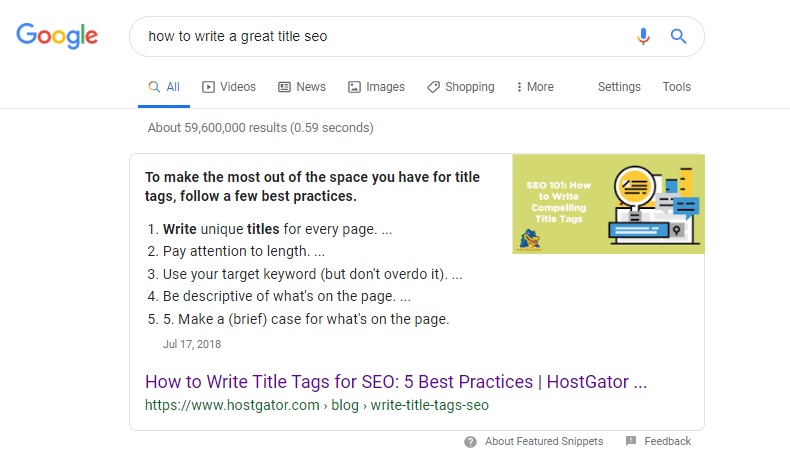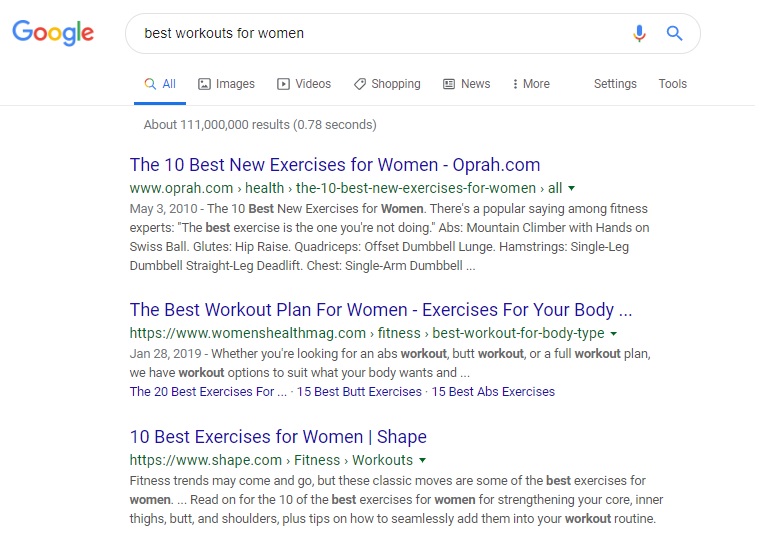When you type in a search phrase in your favorite search engine, what is the result? A list of titles linked to relevant content. You can the list of titles and maybe the meta descriptions, looking for the option that best fits your search phrase. When you find it, you click to follow the link – it’s that simple.
When it comes to building SEO on your site, crafting effective title tags is actually more complex than you might imagine. It seems obvious to simply explain what the content is about, but everything from the number of words in the title to the order of those words can make a difference when it comes to SEO. Read on to learn more about title tags and how to use them effectively on your site.
What is a Title Tag, Anyway?
Though it may seem obvious, it is worth exploring exactly what a title tag is and what function it serves on your website. The title tag is the main part of a website’s listing on the search engine results page (SERP). It appears in blue and in a larger font than the meta description below it. It also functions as a hyperlink to the site. Once you click on the hyperlink, you’ll notice that the title tag also appears in the tab at the top of your browser. If you look in the HTML code, you’ll also find it in something like this: Title of Page.
If you’re not familiar with the HTML code above, don’t worry – you’re not doing something wrong. Many websites these days run on WordPress platforms with SEO plugins that enable you to simply plug in the title text in the appropriate field. The same goes for headings – you simply highlight the text and choose the appropriate tag. Creating a title tag is easy enough, but what role do they play in SEO?
Why Are Title Tags Important?
Any search engine’s primary goal is to deliver results relevant to search phrases. In order to highlight relevant content, the search engine needs to be able to tell what any given web page is about. The algorithm looks not only at the words on the page but also at certain parts of the page to determine the content’s theme. The title tag is weighted very heavily in this equation.
A title tag is a short and sweet way for website designers to tell search engines (and readers) what the page is about. This being the case, you can now understand why title tags are one of the most important tools for on-page ranking.

On top of playing a key role in on-page ranking, title tags are also important when it comes to getting people to actually click on the link that takes them to your page. The title is the first thing readers notice and it is generally what they read to determine whether the page might be a good fit for their search phrase. In this way, title tags are less about improving rankings and more about getting people to actually click on the link once it shows up in their search results.
Are title tags really that important? According to a case study performed by Ahrefs, improving the title tag on a webpage can lead to a 37% increase in web traffic. If you’re not optimizing the title tags on your website, you’re wasting a huge opportunity to increase traffic and improve rankings.
The Top 10 Tips for Writing an Effective Title Tag
Search engine optimization is a combination of many different tactics, and it is impossible to do them all perfectly. If you want to gain the maximum result from the minimum effort, improving your title tags is a great option. It takes no more than a few minutes of your time to revamp a title tag and, evidenced by the study referenced above, it can yield a major impact.
Here are some simple tips for writing effective title tags:
- Make sure to stay within the 50-60 character limit. If your title tags are too long, Google will truncate them – cut them off after a certain number of characters. Stick within the 50- to 60-character limit to ensure that your whole title appears on the page.
- Stick to regular capitalization. If you’ve ever received a text message in all caps, you know how annoying it can be. Stick to regular capitalization with your title tags instead of trying to stand out with all caps. There are two options for capitalization that are acceptable: capitalizing the first letter in the first word or capitalizing the first letter in most words.
- Target a primary keyword. Keywords are king when it comes to driving rankings on search engine results pages, but you don’t want to overload your title tags. Pick the most important keyword to feature in your title tag and save the others for headings within your content.
- Consider including a long tail keyword. If you’re writing about a specific topic like “best workout tips for women,” your search volume may be fairly low. A simple way to boost it is to include a long-tail keyword in the title tag to drive organic site visits. There are plenty of sites online that can help you find the long-tail variations of your primary keyword.

- Make sure your title tags are unique. Every page on your website is unique, so make sure that your title tags are as well. Each page should feature customized SEO features such as keywords, title tags, headings, and alt text.
- Create title tags that are honest and accurate. You’ve undoubtedly come across your fair share of “clickbait” articles, and that’s exactly what you want to avoid if you’re trying to drive genuine traffic to your site. Make sure your title tags are accurate and descriptive of your content – be honest and straight to the point instead of trying to trick readers into clicking.
- Throw in an adjective if appropriate. If you’re covering a subject that is very popular, you want to find a way to make your site stand out in the crowd. A simple way to do this is to throw in an adjective in front of a descriptive keyword, emphasizing what kind of value the page provides to your readers. Here are some of the qualities readers value most that you can include in your title tag to encourage people to choose your site over your competitor’s:
- Depth and thoroughness. There is a clear correlation between page length and rankings – readers want high-quality and in-depth resources.
- Lists. Readers love lists, so if you’re using a list in your content be sure to include a number in your title tag.
- Speed. Though in-depth resources are highly valued, sometimes it’s better to just cut straight to the point. Using words like “simple,” “quick,” and “today” can tell your readers that the content is simple and easy to use.
- Freshness. Readers don’t want outdated information, so throwing a date into your title tag might help (ex: Best SEO Tips for 2019).
- Brand. If your brand is already established within the industry, use it! Include your brand name or a site name in your title tags.
- Optimize for CTR once you hit the top 10 on SERPs. Click-through rate plays a major role in ranking, but there’s not much point in optimizing for it until you start ranking on that first page. Why? Because most people don’t scroll past the first page.
- Inject emotion into your title tags. When CTR becomes the focus of your site, you should start using powerful words to keep your site on that first page. Words that inject emotion like “amazing” or “remarkable” and try to address some pain points within your title tags.
- Pay on people’s curiosity. Once you’ve started ranking well in SERPs, another strategy you can use to continue driving traffic is to create title tags that inspire curiosity. Throw a quick phrase into parentheses or make a statement with your title tag that leaves the reader wanting more.
If you want readers to click on your links on SERPs, you need to optimize your title tags. In addition to telling potential readers what your site is about, title tags serve as the reader’s first impression of your brand. Follow the simple tips above to make sure that the first impression is a good one!
